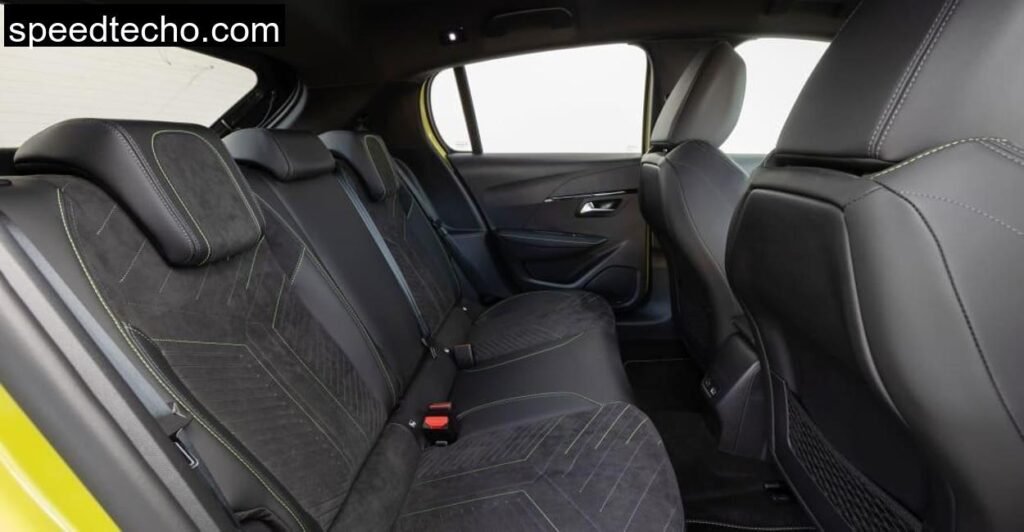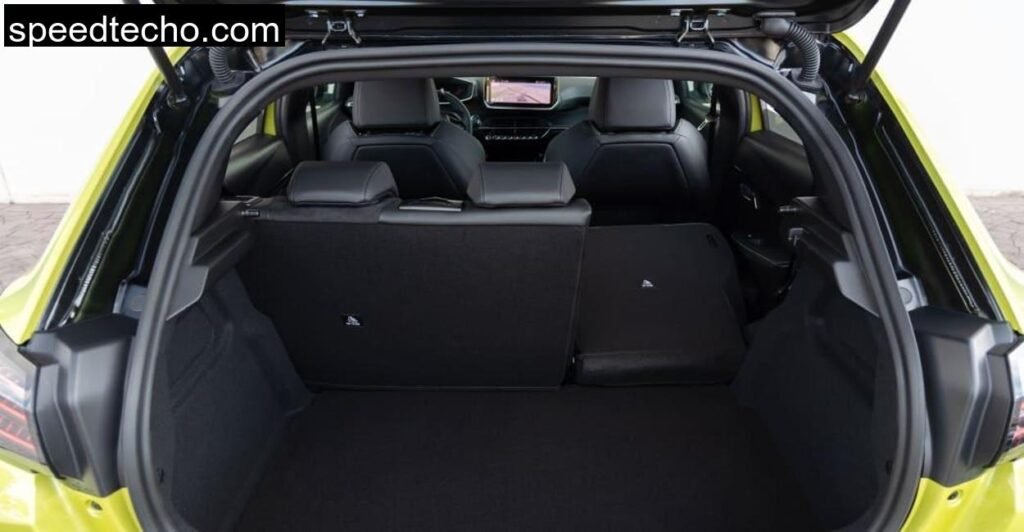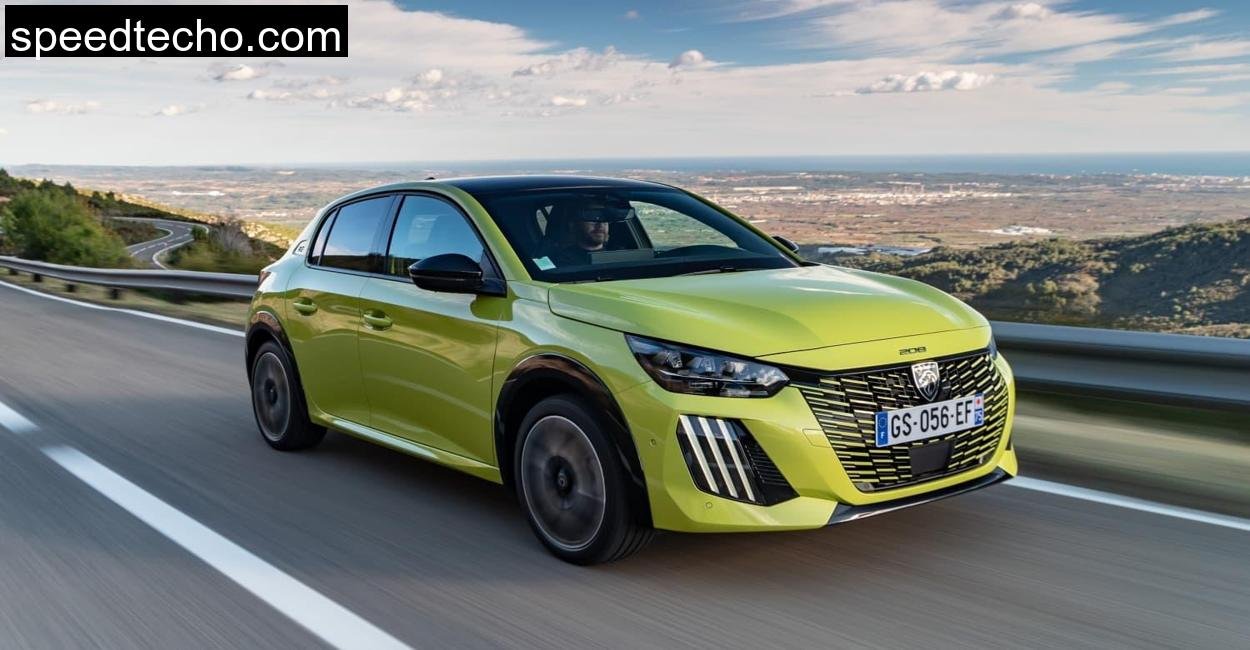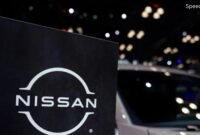A Familiar Face With Sharper Edges
The first impression is purely visual, and Peugeot’s facelift doesn’t disappoint. The front now wears the brand’s modernized logo proudly, framed by fang, shaped daytime running lights that look like they’re ready to pounce. The three, claw tail lights at the rear are even more dramatic now, echoing design cues from the larger 308 and 508.
It’s a good, looking little hatch, no question. Small, but not dinky. There’s maturity in its proportions now, and the GT version adds a bit of swagger with larger wheels and gloss, black accents. But nothing shouts “electric,” which is kind of the point, Peugeot has always wanted the e, 208 to blend into the regular 208 lineup.
The paint finish on my test car, a rich Elixir Red, caught the Westerwald’s shifting light beautifully, cloud, filtered sun in the morning, misty forest hues in the afternoon. A subtle reminder that small doesn’t have to mean boring.
Cabin Comfort and the Quirks of i, Cockpit
Inside, Peugeot has stuck with its love, it, or, hate, it i, Cockpit layout. That means a small steering wheel mounted low, and a 3D digital instrument cluster you’re supposed to look over the wheel, not through it. I’ll be honest, I’m tall, and this setup is always awkward at first. But after adjusting my seat height and tilting the wheel just right, I got used to it. Eventually.
The 10, inch touchscreen is bright and neatly integrated into the dash, angled slightly toward the driver. It’s standard now across all trims, and while it looks slick, the menu structure is convoluted. Changing the fan speed or switching from nav to media takes too many taps. Peugeot tries to help with quick, access “piano keys” below the screen, but they’re touch, sensitive and not grouped by function. More form than function here.
Material quality is generally good. There’s some soft, touch plastic, fake carbon fiber, and a smattering of piano black that loves fingerprints. The GT version throws in alloy pedals and contrast stitching. It’s stylish in a modern, French way, bold, but not overbearing.
Space in the front is generous. At 1.90 meters tall, I had room to stretch my legs and still not brush the ceiling. The rear seat is another matter. It’s fine for short hops or small passengers, but adults will feel the squeeze. The battery layout doesn’t steal interior space, which is a plus, Peugeot cleverly tucks it under the floor thanks to the shared CMP platform.

Out on the Road: The Real, World Westerwald Test
I left the town of Hachenburg and pointed the e, 208 toward Bad Marienberg, choosing backroads rather than autobahn. These are the kinds of roads that snake through meadows and small villages, with the occasional tractor to overtake or a tight corner to thread through.
Here, the e, 208 feels composed and agile. The electric motor’s 270 Nm of torque makes it easy to dart between curves. It’s not razor sharp, but it’s quick to respond, especially in Sport mode, which tightens throttle response and gives a subtle growl through the synthetic sound generator. I used it more often than I expected.
Steering is light and reasonably direct, though still a bit vague around the center. At higher speeds, like on the B414 toward Altenkirchen, I noticed a touch of wander, minor corrections were needed to keep the car perfectly straight. Nothing dramatic, but enough that it kept me from fully relaxing. Straight, line stability could be better.
That said, the e, 208 is impressively quiet. There’s very little motor whine, and wind noise only becomes noticeable above 110 km/h. Even then, road and tire noise remain controlled. In town, it’s whisper, quiet, ideal for sneaking past bakeries before 8 a.m.
Charging and Range: Finally Useful Numbers
Let’s get into the meat of the matter: how far can it go and how fast can it charge?
Peugeot claims 409 km on a full charge for the 156 hp version. In my experience, I averaged about 360 km, driving normally, some Eco mode, some Sport, heating occasionally on in the morning. That’s real range, not wishful thinking. The previous e, 208 I tested managed only about 280 km on the same roads. So yes, this is a big improvement.
The car’s 51 kWh usable battery (54 kWh gross) supports up to 100 kW fast charging. I tested it at a local EnBW station and hit a peak of 102 kW, just as promised. From 20 to 80 percent took about 29 minutes. That’s enough time for a coffee and stroll around the charging plaza, not an overnight ordeal.
Home charging is slower, of course. My test car had the optional 11 kW onboard charger, so topping off from 10 to 100 percent at a wallbox took about 5.5 hours. Acceptable for overnight.

Performance Numbers vs. Feeling Behind the Wheel
Peugeot now gives you a choice between the older 136 hp motor or the newer 156 hp unit. My test car had the latter, and it makes a difference, not just on paper, but in daily use.
From a standstill, it feels eager. The 0, 100 km/h time is 8.3 seconds, but it’s the in, town punch that impresses most. Merging onto the autobahn outside Neuwied, I was up to 120 km/h in what felt like no time. The power delivery is smooth and uninterrupted, with no gears to shuffle.
Top speed is limited to 150 km/h, which I reached briefly before traffic dictated otherwise. That’s fine for Germany’s highways and perfect for every other country. More importantly, the car doesn’t feel stressed at those speeds.
Is It Now a True Everyday EV?
Absolutely. The e, 208 has matured. It still has quirks, the i, Cockpit isn’t for everyone, the infotainment needs refinement, and rear, seat space is tight, but those feel secondary now.
What matters is that it drives well, feels peppy, charges quickly, and finally offers real, world range that covers daily and weekend needs without anxiety. In the Westerwald, a place with plenty of countryside between towns, the e, 208 didn’t feel out of place or underprepared. It just worked.
It’s no longer just a “good second car.” It’s a legitimate only car, especially for singles or couples without huge cargo needs.
Conclusion: A Small EV With Big Potential
After a week in the Peugeot e, 208, I didn’t want to give it back. It’s one of those rare cars where charm and competence meet. The updates have made it more efficient, faster, and far more livable. The new motor isn’t just marketing fluff, it’s transformative.
If you’re looking for a compact electric car that feels more grown, up than its size suggests, the e, 208 finally delivers. Not just in the city, but in the real, world rhythm of places like the Westerwald, where life is slower, roads are curvier, and a car needs to be more than a showroom spec sheet.
Can e-208 tow anything?
Unfortunately, like many small EVs, the e, 208 is not rated for towing.
How far can I drive on a single charge in e-208?
Realistically, 315, 330 km with mixed driving. Light, footed city use could push it closer to 350 km.
Is the e-208 comfortable for long road trips?
It’s comfy enough for regional jaunts, but limited range and high, speed stability make it less ideal for extended Autobahn runs.






